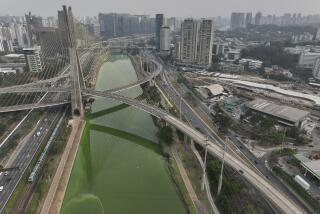Water Rationing Shapes Customs, Lives in Brazil
- Share via
SAO PAULO, Brazil — Sweeping dry leaves and dust from her small front yard, Magali Silva Santos suddenly turned around and shouted: “That’s enough! Don’t waste any more water!”
It was a reprimand to her 15-year-old daughter, who was breaking a new family rule limiting showers to five minutes.
Santos is one of close to 3 million people--nearly a third of the population of South America’s biggest and wealthiest city--for whom water is being rationed under authorities’ “2-and-1 plan”: two days with water, one day without.
The rationing, which began June 1 and is scheduled to last through early November, is affecting more than 500 districts of southern Sao Paulo, where rich and poor alike depend on the 250-square-mile Guarapiranga Reservoir for their water.
So far the plan seems to be working, and the day-to-day lives of residents seem basically unchanged, aside from some minor adjustments.
“I no longer hose down my front yard, and instead of washing clothes once or even twice a day, I am now doing my wash once a week. And we’ve also cut our bathing time from ten to five minutes,” Santos said.
Her neighbors in the low-income district of Jardim Angela made similar remarks, saying they have learned to cope with periodic water shortages and rationing during the normally dry May-October period.
“Rationing? We’re used to it,” said Silvana Ferreira. “Every couple of years there is a water shortage, so this is nothing new for us. The rains will come back and things will be back to normal in a few months.”
Officials hope that’s true.
The Sao Paulo state water and sewage utility says rainfall between last October and April was almost 30% below average. As a result, the Guarapiranga Reservoir has fallen to 15.4 billion gallons, or 37% of capacity.
If normal rains don’t return in November, city officials warn, they may have to impose more severe controls--perhaps one day with water, two days without.
Worsening matters are some 300,000 squatters who in recent years have illegally occupied land near the reservoir. The squatters have destroyed surrounding vegetation, drying up a network of underground springs that helped replenish Guarapiranga.
“The haphazard occupation of the area has waterproofed the ground, making it impossible for rainwater to penetrate the soil and feed these springs,” said Antonio Fernando Monteiro, an ecologist at Sao Paulo State University.
More to Read
Sign up for Essential California
The most important California stories and recommendations in your inbox every morning.
You may occasionally receive promotional content from the Los Angeles Times.













